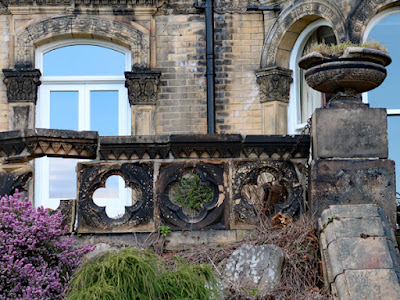My brief surveys of Kersal Mount and Tapton Hall had provided me with plenty of photos to choose from, when giving my talk for the Ranmoor Society in September 2022, and I continued my walk by having a quick look at the sandstones used in the boundary walls down Shore Lane.
A long section of walling is built continuously from nearly the top of Shore Lane and ends at a point opposite the entrance to the Ranmoor Village at Woodhead Way, which I assume to be from quarry in the Rough Rock on the opposite side of the road to the entrance to Tapton Hall.
 |
| A boundary wall built with Crawshaw Sandstone |
From this point down to Fulwood Road, the stone used in a separately built wall has a very different character, with much more evenly shaped and sized blocks of a medium grained sandstone. It is a greyish sandstone with considerable orange iron staining and banding, with planar bedding that is characteristic of the Crawshaw Sandstone from Bolehills in Crookes – 1.5 km to the north as the crow flies.
When I first visited Fulwood a few years previously, I had been quite amazed to see so many large Victorian houses from the top deck of the No. 120 bus, which had been built during the expansion of the western suburbs in the second half of the C19.
 |
| Victorian houses on Broomhall Road |
This time, when walking along Fulwood Road to Broomhill, I could only get glimpses of these houses behind high boundary walls or thick hedges and was therefore unable to glean much information about the sandstone used to build them.
 |
| Broomhill Community Library on Taptonville Road |
Arriving at Taptonville Road, where I had photographed its various listed buildings during a brief exploration of the Broomhill and Endcliffe Conservation Areas a few months earlier, I had another look at the Broomhill Community Library, where it looks like Crawshaw Sandstone with iron staining has been used for the walling.
 |
| Crawsha sandstone at Broomhill Community Library |
On the opposite side of the road, I was interested to see that some of the tarmac on the road has deteriorated to the extent that the original setts have been exposed. These were quarried from several sandstone formations in Sheffield, particularly the coarser varieties such as the Loxley Edge Rock and the Chatsworth Grit, a coarse pebbly variety of which has been used here.
 |
| A road sett on Taptonville Road |
I returned to Fulwood Road and headed up Crookes Road to find the early C19 No. 17 Pisgah House Road and the Etruria House Hotel (1876), formerly owned by John Armitage, a manufacturer of decorative fired clay products.
As also seen at the warehouse and showroom at No. 140 Devonshire Street, the house is ornamented with many of his firm’s products but, with the approach to this being on private land, I didn’t spend any time looking at the fabric of the building and just took a few record photographs.
Continuing my walk, I retraced my steps down Crookes Road and then took a few photos of the former Broomhill Board School, to have another look at its walling stone. The book Building Schools for Sheffield describes it as stone from Dunford Bridge, where coarse grained Huddersfield White Rock and Rough Rock from the Millstone Grit Group is found.
When I first saw this school, I had already seen many of the Sheffield Board Schools that are built with Crawshaw Sandstone, which is buff coloured, medium grained, has distinctive planar bedding and is laid in small blocks. I immediately thought that it was another example of Crawshaw Sandstone and, having seen it again, it doesn’t look like a very coarse sandstone from the Millstone Grit Group, but perhaps could be from the flaggy Rough Rock.
I then made my way down to Weston Park Museum, where I wanted to photograph the frieze sculptures by Alfred and William Tory on the 1937 addition to the original Mappin Art Gallery (1887). These are the Shrine of Knowledge above the entrance, with various crustaceans, fishes, reptiles, mammals and birds and a depiction of various Sheffield trades at the southern end of the east elevation.
Although I took a couple of photos of the relief sculpture of the various trades, the Shrine of Knowledge is set beneath a portico and the strong afternoon sunshine created a deep shadow that prevented me from getting a good record of the whole sculpture.









No comments:
Post a Comment